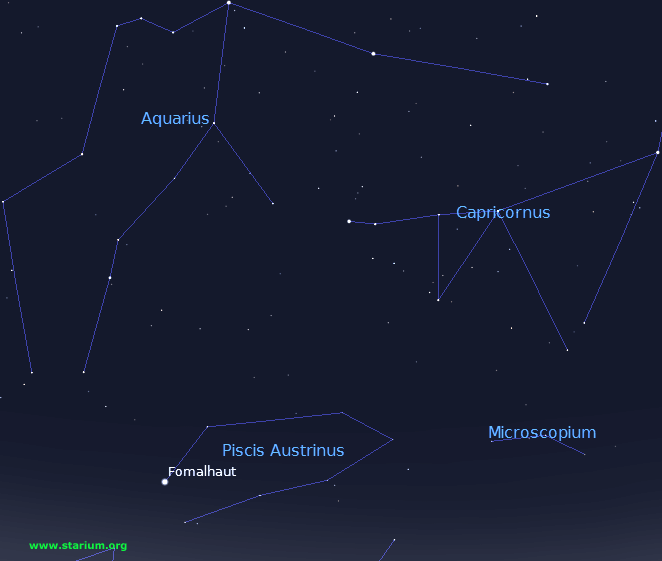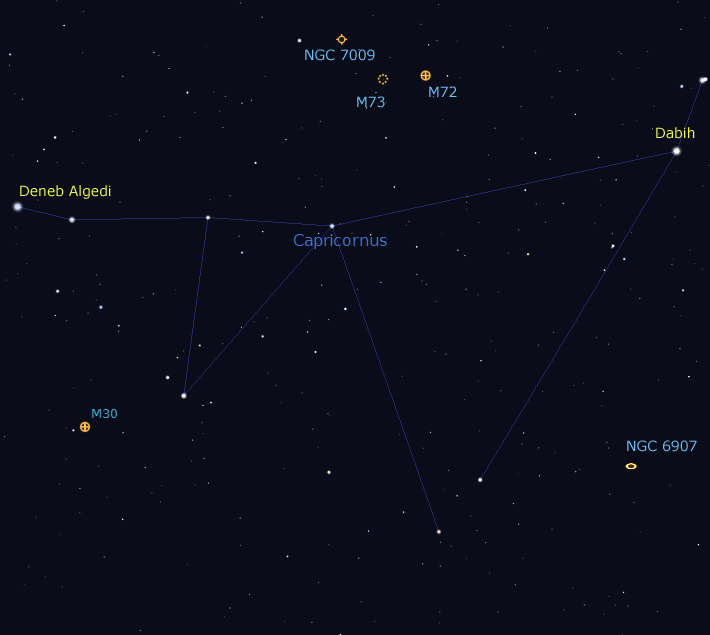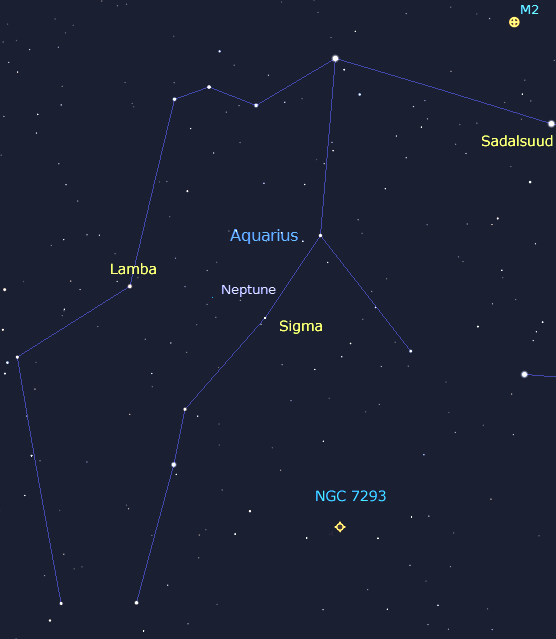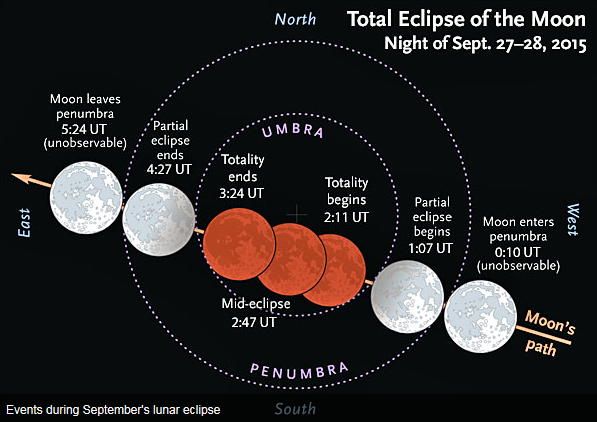Capricorn, Aquarius and a Lunar Eclipse
Moving eastward from the great Teapot of Sagittarius, we continue our voyage along the ecliptic to Capricornus – The Goat. It takes up 414 square degrees of sky, making it 40th in overall size. To date, five stars residing within the boundaries of Capricornus are parents to nine planets. The stars that define the asterism are of average brightness, running in the range of magnitude 2.8 to 4.5.
Deneb Algedi is the brightest of the lot and can be spotted to the far left of the asterism. Pretty well a next-door neighbour, this 39 light-year sun is white in colour and has a spectral class of A5. It also has an unseen companion star that transits across its disk every 1.023 days and drops its brightness by .02 magnitudes. Deneb Algedi located on is calculated to be some 85 times the luminosity of our Sun. Then we have the star Dabih which is found on the far right corner of the asterism. This is a complex multiple star system estimated to be 328 light-years away. What seems like two suns are actually a family of five. Beta 1 is a third magnitude orange coloured spectral class K star. I also have a seventh magnitude companion as well as one that is invisible to the human eye but does orbit the primary every 8.7 days. Beta 2 is a magnitude 6 class “A” star with a second companion only 3 arc seconds away.

One of a few choice objects to hunt down is the globular cluster M30. Hovering as most globular clusters do around the nucleus of our Milky Way galaxy, M30 lies some 28,000 light-years away and measures about 90 light-years across. With a visual magnitude of 7.2, this snowball of stars measures 12 arc minutes wide and is a treat to see in any telescope. NGC 6907 is a barred spiral galaxy with structure. At an estimated distance of 121 million light-years, this galaxy measures 3.4 by 2.6 arc seconds. NGC 6907 is located a little less than five degrees west of magnitude 3.2 Psi Capricorni.
Moving on to Aquarius – The Water Bearer is tenth in overall area with 980 square degrees. The bright star belonging to Aquarius in Sadalsuud and has a magnitude of 2.9. This rare yellow supergiant is located 610 light-years from us. Its mass is six times that of our Sun and has a luminosity some 2,200 times greater. When looking at the star in a scope, you are seeing a triple star system with the first with a magnitude of 11.0 is located 35 arcseconds from the primary whereas the second is a bit fainter at magnitude 11.6 and can be found 57.2 arcseconds from the main star.

Two Messier objects call Aquarius home with the first located to the far western portion of the constellation. At an estimated age of 13 billion years, M2 is one of the oldest and largest globular clusters of the Milky Way Galaxy. It is located some 37,000 light-years from us and 175 light-years wide and contains about 150,000 suns including 21 variables. M2 is registered at magnitude 6.5 and can sometimes be glimpsed naked eye. This globular is located five degrees north of Sadalsuud.
As a sharp contrast from M2, M72 is a small and faint globular cluster. With its great distance of 53,000 light-years away, M72 is on the other side of the Milky Way. M72 spans about 50 light-years across and holds an estimated 100,000 stars. The Messier Catalog does post an entry for M73 with its position in the sky located to the left of M72. The area in question only shows four stars in a ‘Y’ formation. Moving on, we come across the Saturn Nebula (NGC 7009) and as the name depicts, this object takes on the iconic planetary shape which is easily seen in small telescopes and photographs. This greenish-yellow planetary nebula is located 2,400 light-years away with a magnitude of 12.1. Its blue central dwarf star is thought to be a hot 55,000 K. The entire planetary measure 36 arc seconds in length.

We conclude off with the NGC 7293 aka the Helix Nebula. This planetary nebula is very impressive in structure. Its image has appeared on other religious web sites and sometimes referred to as the “Eye of God”. The Helix is only 450 light-years away and is one of the closest planetaries to Earth. Its apparent size in the sky is 16 by 28 arc minutes keeping in mind the full moon measures 30 arc minutes. Aquarius is also home to the farthest main planet of our solar system. Neptune appears as a light blue fuzzball and at magnitude 7.8 is too faint to be seen with the naked eye. Only a telescope can reveal its featureless dot. Because of its 165 year orbit around the Sun, Neptune will not be officially leaving Aquarius until March 2023. Neptune is located between Lambda and Sigma Aquarii.
For the past month or so Saturn was the only planet visible in the night sky. For those following the ringed planet, its time is coming to an end at is set at about 10:30 p.m. local time on the first. But fear not, Venus and Mars are up in the east at around 5 a.m. and you will begin to see Jupiter again starting mid-month. The new moon (lunation 1147) occurs on the 13th and the full Harvest moon slated for the 27 and yes it will be another so-called super moon. This will not be any Harvest moon but an eclipsed Harvest moon.

The geometry of the Sun-Earth and Moon is just right to produce a total lunar eclipse. The entire event will be seen from the eastern half of Canada. The moon will begin to slide into the Earth’s shadow on the night of September 27 at 9:07 p.m. eastern. Mid eclipse or the darkest the moon will occur at 10:47 p.m. with exiting the shadow at 12:27 a.m. and this will be the last eclipse until the year 2018. And lastly, fall begins on September 23 at 4:21 a.m. eastern or 8:21 UT.
On a personal note, it was this month back in 1965 that I was introduced to astronomy. Returning to elementary school at the age of eight for a new school year, I was strolling through the library to see what new books arrived. I happened to come across the old How and Why Wonder Book of Stars. Thumbing through the pages I was astonished by the drawing of our Earth and Sun only to read 109 earths fit across the Sun’s equator and more than a million would fit inside. Then there were distances and colours of stars that kept me coming back for more. As they say, the rest is history. Over the past 50 years, there has not been a day I did not read some book or Sky and Telescope magazine, or look at the night sky when it was clear or teach someone about the sky above. At the age of 13, I bought my tiny refracting telescope from a catalogue store call Consumer’s Distributing back in Montreal which over the years led to bigger and better scopes.
Technology has changed greatly in the past half-century with I am sure more to come. But even with the high tech products of telescopes and CCD cameras on the market today, one should not get too involved in setting up that perfect image and just lookup. Even with an observatory I still find myself looking at the whole sky with binoculars or the naked eye to drink in the same starlight that fueled my excitement when I was young. Sharing the wonders of the night is something we all love to do. For those who are just starting in astronomy, your journey has just begun. Enjoy the beauty of the night. It’s a wonderful classroom.
Until next month, clear skies everyone.
Twitter: @astroeducator
